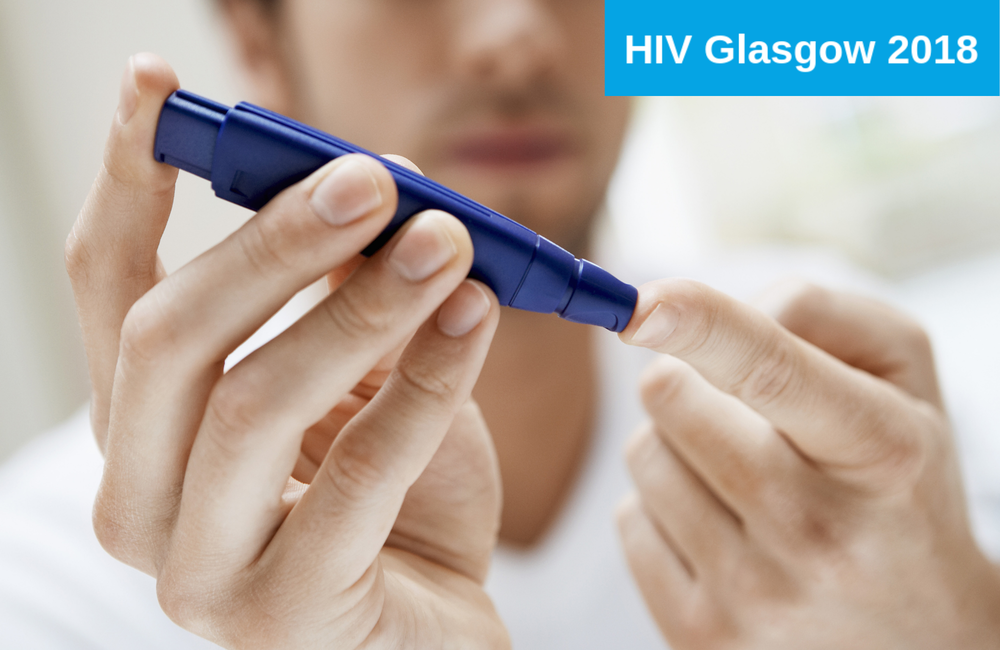
Around a third of people living with HIV receiving care at three large HIV clinics in south London had diabetes or pre-diabetes, while a Liverpool HIV clinic found that 70% of patients with diabetes were not able to achieve targets for blood sugar control, presentations at the International Congress on Drug Therapy in HIV Infection (HIV Glasgow) earlier this month showed.
The findings highlight the need for greater awareness of the risk of type 2 diabetes and poorly controlled blood sugar among people living with HIV, say investigators.
Type 2 diabetes is one of the most common chronic health conditions in older adults. Diabetes UK estimates that approximately 6% of people in the United Kingdom are living with diagnosed or undiagnosed diabetes. The long-term consequences of poorly controlled blood sugar include increased risks of heart disease, kidney disease and sight loss. The risk of developing type 2 diabetes increases with age and is higher in people of South Asian, Black African and Black Caribbean ancestry. Obesity greatly increases the risk of developing type 2 diabetes.
Doctors at King’s College Hospital and Guy’s and St Thomas’s Hospital reviewed the prevalence of elevated glucose levels and type 2 diabetes in 338 people with HIV receiving care at their clinics. The sample was constructed to reflect the demographics of patients receiving care at the clinics; 49% were Caucasian, 31% Black African and 17% Black Caribbean. The median age was 49 years and 74% were male.
The prevalence of type 2 diabetes was high: 15% had diabetes (fasting glucose >7.0 mmol/l) and 17% had pre-diabetes (6.0-6.9 mmol/l). The prevalence of type 2 diabetes and pre-diabetes increased substantially in people aged 40 and over. Whereas 14% of those aged 40-49 had diabetes and 17% had pre-diabetes, in both the age groups 60-69 and 70-79, the prevalence of diabetes increased to 33% and of pre-diabetes to 25%.
To assess whether QRISK2 scores for 10-year cardiovascular risk could predict the presence of pre-diabetes, the researchers plotted pre-diabetes diagnoses against QRISK2 scores and found that a score of 4 or above predicted an increased diabetes risk with a sensitivity of 72% and a specificity of 51%.
The study investigators concluded that in the absence of an up-to-date HbA1c measurement, anyone aged 40 or over with a cardiovascular risk score of 4 or above on the QRISK2 tool should be investigated for pre-diabetes or diabetes.
Lipodystrophy and diabetes risk
The same research group also found a strong association between current or past lipodystrophy and the subsequent development of type 2 diabetes.
Why might people who develop lipodystrophy go on to develop type 2 diabetes? Changes in body fat distribution after starting antiretroviral treatment – subcutaneous fat loss from the limbs and face or visceral fat accumulation in the abdomen – are rare nowadays. In the past, these changes were associated with protease inhibitor-based treatment, especially when combined with the nucleoside reverse transcriptase inhibitors stavudine or zidovudine. These drug combinations also cause metabolic changes that may promote the development of diabetes.
In the cohort analysed for diabetes, 22% had been diagnosed with lipodystrophy (fat accumulation or fat loss). People with lipodystrophy were twice as likely to have been diagnosed with type 2 diabetes as people without lipodystrophy, suggesting that anyone with a current diagnosis of lipodystrophy or a history of lipodystrophy should be screened for diabetes.
Monitoring
How are HIV clinics doing at monitoring whether type 2 diabetes is being controlled successfully in their patients? The Royal Liverpool Hospital evaluated its own performance and concluded that glucose and blood pressure control in their diabetic patients were sub-optimal. In the cohort of 1123 patients, the age-adjusted prevalence of type 2 diabetes was 3.4%, leading the investigators to suspect that diabetes may be under-diagnosed in their clinic population.
Out of 60 patients with diabetes or pre-diabetes, only 30% had achieved their HbA1c target, despite 81% receiving some form of medication. Blood pressure control was better in this cohort: 18 out of 35 with hypertension had achieved a blood pressure control target.
The evaluation also identified issues regarding antiretroviral prescribing. Although all patients were on antiretroviral therapy, 8 out of 60 patients with diabetes were receiving abacavir, which may further increase the risk of cardiovascular disease in a group of patients already at higher risk. Four out of 19 patients with renal impairment and diabetes were receiving a drug associated with an increased risk of kidney damage, either tenofovir disoproxil or atazanavir.
Communication with GPs is critical for managing diabetes in people with HIV: the British HIV Association recommends that management should be carried out in partnership with GPs to avoid duplication. In practice, this means that GPs are likely to be responsible for day-to-day management and the prescription of medication to manage diabetes and hypertension. The evaluation found that for 97% of patients with diabetes or pre-diabetes, there was evidence of communication with a GP.
The researchers concluded: “We need to better manage diabetes in HIV to reap the benefits of gains in healthy life expectancy provided by antiretrovirals. This might be achieved through clinician and patient education, or integration of HIV and diabetes services.”
Mok J et al. Dysglycaemia is prevalent in HIV patients over 40 and may be detected using routine screening for cardiovascular risk. International Congress on Drug Therapy in HIV Infection (HIV Glasgow), Glasgow, 2018, abstract P191. View the poster.
Mok J et al. Current or historic HIV-related lipodystrophy largely associated with protease inhibitor exposure is a predictor of future diabetes risk. International Congress on Drug Therapy in HIV Infection (HIV Glasgow), Glasgow, 2018, abstract P192. View the poster.
Smith H et al. How well do we manage type 2 diabetes and abnormal glucose metabolism in HIV? A service evaluation. International Congress on Drug Therapy in HIV Infection (HIV Glasgow), Glasgow, 2018, abstract P198. View the abstract.
